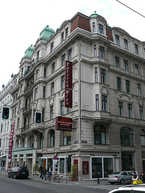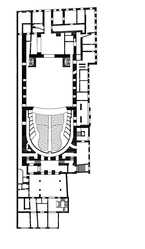Theater an der Wien
Franz Jäger the Elder
alias Kaiserl. Königl. privilegiertes Schauspielhaus Theater an der Wien, Theater an der Wien -The New Opera House, Playhouse of imperial and royal privilege Theater an der WienLinke Wienzeile 6, 1060 | |
| mostrar en el mapa | http://www.theater-wien.at/index.php/en/home |
eventos importantes
On 13th June 1801 Emanuel Schikaneder opened the Theater an der Wien as the “Playhouse of imperial and royal privilege” with his own work, the allegorical gala prologue Thespis Traum, and the heroic opera Alexander by Franz Teyber.The building was designed by the architect Franz Jäger in Empire style.
In 1902 Ferdinand Fellner & Hermann Helmer built a 5-storey apartment house above the theatre's Wienzeile wing.
The theatre was closed for safety reasons in 1955. In 1962 the theatre found a new and successful role for itself as a venue for contemporary musical theatre after reconstruction by Otto Niedermoser (auditorium received original colour design again; restoration of frescoes and other stucco work; installation of a heating- and air-handling system, as well as lowerable concert platforms in the front part of the stalls, a revolving stage and a new headlamp system, oil-induced transformers for current supply; amplification of the fundament - ferro-concrete structure).
Gente
Historia
The success of Mozart’s Magic Flute at the Freihaus theatre encouraged actor, librettist and director of the Freihaus theatre, Emanuel Schikaneder, to have the Theater an der Wien (Theatre on the River Wien) built at Laimgrube an der Wien 26, on the left bank of the River Wien. Having written the libretto, Schikaneder also played the part of Papageno at the premiere of Mozart’s masterwork, being apparently one of the most industrious figures in Viennese theatre at the time. With the financial support of Schikaneder’s fellow mason, the proprietor of the Freihaus theatre Bartolomäus Zitterbarth, the theatre was built between 1800 and 1801 and the run down Freihaus theatre was closed. Court architect Rosenstängel designed the building and construction was supervised by the (civic) builder Anton Jäger and his father Franz Jäger, a civic as well as court stonemason.
Being one of the well-known suburban theatres, along with the theatre in Josefstadt and the Leopoldstadt Theatre, the Theater an der Wien remained Vienna’s most modern and largest theatre until the erection of the new Court Opera in 1869. Its complex stagecraft and auditorium’s architectural features were admired by aristocratic and suburban audience alike. Compared with other court theatres, the Theater an der Wien was equipped with more comfortable seats, and also provided a better view of the stage from the boxes. The theatre’s simple Empire Style portal on the main front, through which the nobility and those holding box seats had their separate entrance, is furnished with a sandstone sculpture by Jakob Schroth featuring Emanuel Schikaneder as the birdcatcher Papageno, and his children as three boys from the Magic Flute (‘Papagenotor’), thus forming a memorial to him. The house underwent several major changes, being enlarged only twenty years aft er its opening. In 1838 the auditorium was restored, and the interior, originally blue-silver, was redecorated in red and gold. The Papageno Gate was expanded to include three gates in 1845, and modern machines were installed in the stage section. In 1854, the trabeated ceiling of the auditorium was furnished with paintings of the nine Muses by Josef Geyling the Elder, which were restored in 1962.
Architects Ferdinand Fellner and Hermann Helmer were in charge of a major renovation in 1901 when the fourth gallery of the U-shaped auditorium and parts of the pillars adorned with Atlantes were removed. A Biedermeier building at the front was pulled down and replaced by a four-storey apartment building in fin de siècle style, combining elements of Historicism and Modernism. The theatre’s vicinity was likewise subject to several changes. After the River Wien was covered over in 1910, the popular Viennese market Naschmarkt was set up in the theatre’s immediate neighbourhood. In 1938 when the theatre’s general manager Arthur Hellmer had returned his concession and was forced to emigrate because he was considered ‘Jewish’ by the Nazi race doctrine, the house was closed. Although the Theater an der Wien was host to occasional guest performances up to 1945, necessary refurbishments were not carried out because of the war and so the theatre’s regular business was not carried on.
From 1945 to 1955 the Theater an der Wien was used as a stage for the destroyed Wiener Staatsoper (Vienna State Opera), aft er which time there were plans to turn it into a cinema or a garage. However, this fate was avoided when the City of Vienna became the legal owner in 1960. Between 1960 and 1962 the theatre was rebuilt by architect Otto Niedermoser, expanding the listed building through loft conversions and additional basements, creating more space for the audience and stagecraft including, for example, the installation of a revolving stage. Niedermoser also participated in the reconstruction of the Vienna State Opera. His architectural style is characteristic of a certain sobriety following simple and functional criteria. Despite his wide-ranging activities as a builder in film and theatre, he was also very active as an architect, rebuilding various theatres as well as private houses in Vienna and contributing to the construction of the Werkbundsiedlung (Werkbund Housing Estate) in the 1920s.
The Theater an der Wien is used as a venue for performances of various genres, depending on the respective proprietor and contemporary taste. At the time of its inception it presented operas (such as Beethoven’s first version of Fidelio in 1805), spectacular epic operas, and later Viennese folk plays, especially by Ferdinand Raimund and Johann Nestroy. From the 1870s onwards not only operettas but also critical folk plays (e.g. by Ludwig Anzengruber) came to be performed. At the turn of the century the theatre became a stronghold of operetta by Franz Lehár and Emmerich Kálmán. In the 1960s the Theater an der Wien was also used for the Wiener Festwochen (Vienna Festival), and over the next three decades it gained an international reputation as a famous European venue for musicals. Since 2006 the theatre has been staging operas as well as hosting the Vienna Festival.
Tickets: +43 (0) 1 588-85
Tel. infos: +43 (0) 1 588-30-660
E-mail: oper@theater-wien.at
http://www.theater-wien.at/index.php/en/guided_tours www.youtube.com/user/theateranderwien
www.facebook.com/TheateranderWien
Visits: guided tours regularly (see website for dates) ∙ guided tours for groups on appointment
Autores: Brigitte Marschall, Fritz Trümpi, Carsten Jung
Brigitte Marschall:
Fritz Trümpi:
Carsten Jung:
Información adicional
Ninguna información se ha introducido todavía
Añadir información
